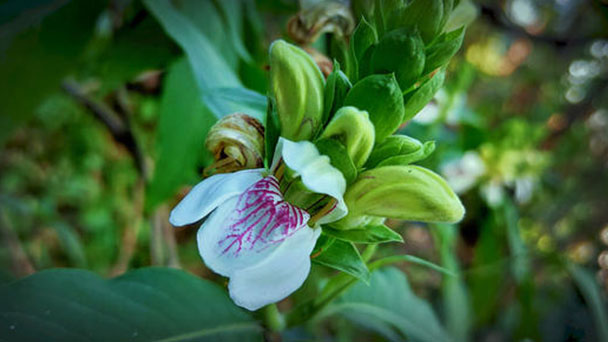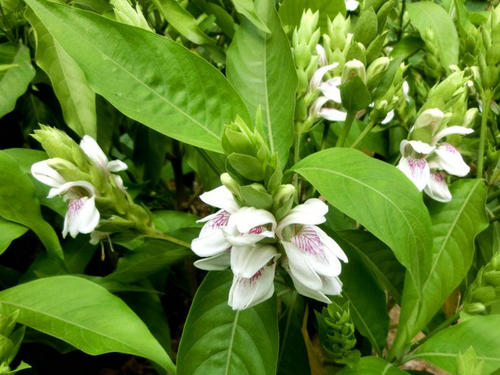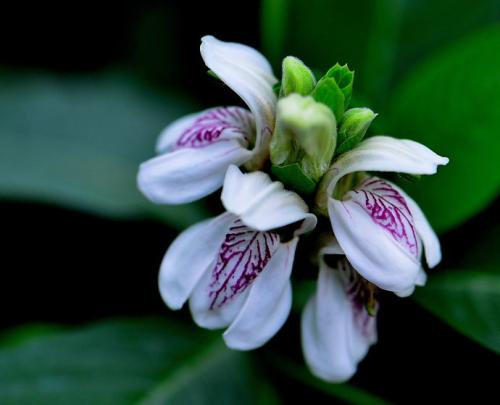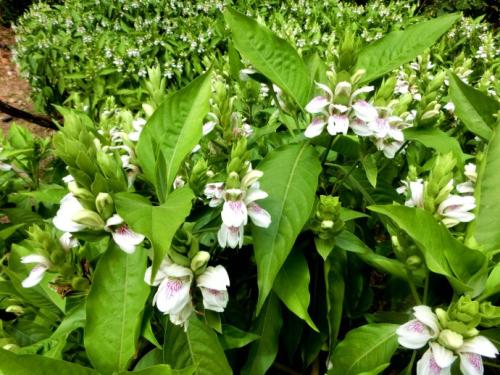Malabar nut (Justicia adhatoda) profile
Written by Maggie
Mar 16 2021

Malabar nut (scientific name: Justicia adhatoda), also called adulsa, adhatoda, vasa, vasaka, is a species of the genus Malabar nut. Malabar nut is a shrub, 2 -- 3m tall, nodules dilated, young branches hairy, opposite leaves, oblong-lanceolate or oblong-elliptic, tip acute, entire, spikes terminal or axillary, bracts ovate, corolla labial, white with purple lines, spring and summer flowering.
Malabar nut picture

Morphological characteristics of Malabar nut
Branch
The Malabar nut is a large shrub, 1 -- 3 m high; Branches are terete, gray, lenticellata, twigs densely covered with grayish white puberulent.
Leaf
Leaves of Malabar nut are papery, rectangular oblong-lanceolate to lanceolate, or ovate or elliptic ovate-ovate, 15 -- 20 cm long, 4.5 -- 7.5 cm wide, apically acuminate, sometimes slightly caudate, basally broadly cuneate, entire, upper sub glabrous, abaxially puberulent; Midvein in upper mask groove, lateral vein about 12 on each side; Petiole is 1.5-2 cm long. Stems and leaves after rubbing a special odor.
Flowers
Malabar nut is a spike ovate or slightly elongate; Pedicels are 5-10 cm long;Bracts ovate or broadly ovate, 1 -- 3 cm long, 8 -- 15 mm wide, puberulent; Bracteoles are lanceolate, slightly shorter than bracts, calyx lobes 5, moment oblong-lanceolate, ca. 8 mm long; Corolla is white, purplish streaked or pink, 2.5-3 cm long, pilose, crown tubes ovate, ca. 6 mm long; The locules are elliptic, usually with spherical appendages inconspicuous at base.
Malabar nut blossoms in spring and summer.
Fruit
The capsule of Malabar nut is subwoody, ca. 0.5 cm long, with 4 seeds above, and a solid short stalk below.
The ecological habits of the Malabar nut
Malabar nut is fond of warm and humid climates, not resistant to cold and frost, but tolerant to shade. Its leaves are easy to scorch under direct light, and it likes loose, fertile and sandy loam with good drainage.
Cultivation of Malabar nut
(1) The soil used in the small pot is: black soil 40%, coarse sand 15%, horse dung 30%, and rotten soil 15%, and used after mixing.
(2) The soil used for basin change is: black soil 40%, river soil 20%, coarse sand 15%, horse dung 25%, and human dung 5%, and used after mixing.
Can be divided into indoor culture and outdoor culture.In the indoor culture, placed in the greenhouse should be above 8℃ in the sun;Cultivate it outdoors in a semi-shady place.Other and general woody flowers the same.
Malabar nut propagation
Malabar nuts can be propagated by sowing method and cutting method. The sowing method is the same as that of common flowers. Cuttage method: do cuttings with young stems, can be divided into two periods of cuttings, cuttage method and general woody flowers the same.
Malabar nut cutting should be carried out in spring, planting in spring. During the growth of the semi-shady place, the growth of regular watering, and pay attention to maintain the soil and air humidity. Apply thin fertilizer every half a month, mainly with nitrogen fertilizer. After the flowers fade, cut off the residual flowers in time.The overwintering temperature should be above 8℃.

Disease control of Malabar nut
Aphids
1. Use the scent aphids like
Aphids like sweet smells and willow smells.
Specific measures: can use sweet and sour wine (white granulated sugar with hot water, water can not be too much, add vinegar and wine, can smell the sweet taste) into the white wine small cup or drink medicine in the small measuring cup, in the evening when aphids are active on the victim plant next to. Small families use this method.With willow strips, rubbing, bundling, can attract a large number of aphids, and then concentrate killing. It is suitable for large areas with serious disasters. Because plants have certain defenses they don't have to worry about a few aphids.
2. With plant ash water
With plant ash (can be burned with hay, burned out after the remaining ash) and water according to 1:5 to foam, spray to the victim plant where aphids can be more convenient. And can supplement potash fertilizer, kill two birds with one stone.
Use black light to take advantage of aphids' phototaxis. This can be used in any situation. It can not only kill aphids, but also avoid other pests.
3. The use of irritant pepper water
Pepper water to take a certain amount of dry pepper or pepper, boil in boiling water until the water discoloration, such as water cool, take out the impurities, and then put the pepper (pepper) water spray on the victim of the plant, the effect is obvious.
4. Use insecticides
1 grams of urea, 1.25 grams of washing powder, 100ml of water to prepare a small spray, but can not be used too frequently.
Use imidacloprid and follow the instructions on the package without damaging the flowers.
Scale insects
Discover individual leaf or branch have scale insect, usable soft brush gently brush to remove or use cotton flower group, cloth group erase, also can combine pruning, cut insect leaf, insect branch.Brush, cut, focus on burning, do not throw;
Scale insects occur, to use pharmaceutical prevention and control, mainly caught in the egg hatching period spray, because at this time shell has not yet formed or thickening, with pharmaceutical kill.If the wax shell has formed, the spray is not effective.
The agent can choose 40% oxidize dimethoate, 50% malathion, 25% iminophos emulsion, 80% dichlorvos emulsion 1000 times liquid, every 7 to 10 days spray once, continuous 2 to 3 times;If conditions exist, natural enemies of scale insects can be fed, such as Australian ladybird can prey on cotton blowing scale insects, great red ladybird can prey on grass chlorine scale, red spot ladybird can prey on Japanese tortoise wax scale and brown leaf garden scale.
The distribution of the Malabar nut
Domestic distribution
Malabar nut is produced in Guangdong, Guangxi, Hainan, Macau, Hong Kong, Yunnan, and cultivated in Shanghai.
Foreign distribution
The Malabar nut can be found in Southeast Asia, such as India.
Malabar nut ises
Medical uses
Malabar nut can expel wind and promote blood circulation, disperse blood stasis and relieve pain, bone bridging. For fractures, sprains, rheumatic joint pain, low back pain. Continuing tendon and bone, dispelling wind and pain, dispelling phlegm.
Landscape use of Malabar nut
The potted ornamental Malabar nut can be cultivated in the garden and hedgerow in the warm land of the south.

Latest Updated
- Benefits of Bugleweed - 7 Science-backed Health Benefits
- Bugleweed Dangers & Side Effects - Is It Poisonous?
- How to Plant Evergreen Trees - What You Should Know
- When to Plant Evergreens - Grow Guide for Evergreen Trees
- 12 Wonderful Evergreen Shrubs for Your Garden
- 12 Popular Evergreen Plants with Pictures for Beginners
- When And How To Prune A Lilac Bush Like a Pro
- How to Grow & Care for Lilac Vine (Hardenbergia Violacea)
- Japanese Lilac Tree (Syringa Reticulata) Care & Propagation Guide
- Shumard Oak Pros and Cons - What to Know
Popular Articles
- Winter maintenance of Antirrhinum Majus
- How to Grow Terminalia Mantaly Tree
- How to Grow and Care for Crossostephium Chinense
- How to grow Antirrhinum Majus in spring
- Peristeria Elata (Dove Orchid) Profile: Info & Care Guide
- Underwatered Snake Plant (Sansevieria Trifasciata) - Signs And How To Fix
- How to Care for Brazilian Jasmine Plant (Mandevilla Sanderi)
- How to Grow & Care for Graptopetalum Purple Delight in Summer
- Rosa Chinensis (China Rose): Plant Growing & Care Tips
- How to Care for Baby Sun Rose (Aptenia Cordifolia)